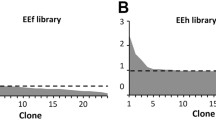Abstract
To ensure the functionalities of the antibodies in phage-displayed synthetic antibody libraries, we use computational method to evaluate the designs of the antibody libraries. The computational methodologies developed in our lab for designing antibody library provide rich information on the function of the designed antibody sequences—adequate antibody designs for a specific antigen type should have predicted paratopes for the antigen type. This computational assessment of the designed antibody sequences helps eliminate non-functional designs before proceeding to construct the library designs in the wet lab. As such, only reasonable antibody designs are constructed for antibody discoveries.
Access this chapter
Tax calculation will be finalised at checkout
Purchases are for personal use only
Similar content being viewed by others
References
Kwong PD, Chuang GY, DeKosky BJ, Gindin T, Georgiev IS, Lemmin T, Schramm CA, Sheng Z, Soto C, Yang AS, Mascola JR, Shapiro L (2017) Antibodyomics: bioinformatics technologies for understanding B-cell immunity to HIV-1. Immunol Rev 275(1):108–128. https://doi.org/10.1111/imr.12480
Jian JW, Elumalai P, Pitti T, Wu CY, Tsai KC, Chang JY, Peng HP, Yang AS (2016) Predicting ligand binding sites on protein surfaces by 3-dimensional probability density distributions of interacting atoms. PLoS One 11(8):e0160315. https://doi.org/10.1371/journal.pone.0160315
Peng HP, Lee KH, Jian JW, Yang AS (2014) Origins of specificity and affinity in antibody-protein interactions. Proc Natl Acad Sci U S A 111(26):E2656–E2665. https://doi.org/10.1073/pnas.1401131111
Mahalingam R, Peng HP, Yang AS (2014) Prediction of fatty acid-binding residues on protein surfaces with three-dimensional probability distributions of interacting atoms. Biophys Chem 192c:10–19. https://doi.org/10.1016/j.bpc.2014.05.002
Mahalingam R, Peng HP, Yang AS (2014) Prediction of FMN-binding residues with three-dimensional probability distributions of interacting atoms on protein surfaces. J Theor Biol 343:154–161. https://doi.org/10.1016/j.jtbi.2013.10.020
Yu CM, Peng HP, Chen IC, Lee YC, Chen JB, Tsai KC, Chen CT, Chang JY, Yang EW, Hsu PC, Jian JW, Hsu HJ, Chang HJ, Hsu WL, Huang KF, Ma AC, Yang AS (2012) Rationalization and design of the complementarity determining region sequences in an antibody-antigen recognition interface. PLoS One 7(3):e33340. https://doi.org/10.1371/journal.pone.0033340. PONE-D-11-14795 [pii]
Tsai KC, Jian JW, Yang EW, Hsu PC, Peng HP, Chen CT, Chen JB, Chang JY, Hsu WL, Yang AS (2012) Prediction of carbohydrate binding sites on protein surfaces with 3-dimensional probability density distributions of interacting atoms. PLoS One 7(7):e40846. https://doi.org/10.1371/journal.pone.0040846. PONE-D-11-25241 [pii]
Chen CT, Peng HP, Jian JW, Tsai KC, Chang JY, Yang EW, Chen JB, Ho SY, Hsu WL, Yang AS (2012) Protein-protein interaction site predictions with three-dimensional probability distributions of interacting atoms on protein surfaces. PLoS One 7(6):e37706. https://doi.org/10.1371/journal.pone.0037706. PONE-D-11-25431 [pii]
Peng HP, Yang AS (2007) Modeling protein loops with knowledge-based prediction of sequence-structure alignment. Bioinformatics 23(21):2836–2842
Weitzner BD, Jeliazkov JR, Lyskov S, Marze N, Kuroda D, Frick R, Adolf-Bryfogle J, Biswas N, Dunbrack RL Jr, Gray JJ (2017) Modeling and docking of antibody structures with Rosetta. Nat Protoc 12(2):401–416. https://doi.org/10.1038/nprot.2016.180
Levy ED (2010) A simple definition of structural regions in proteins and its use in analyzing interface evolution. J Mol Biol 403(4):660–670. https://doi.org/10.1016/j.jmb.2010.09.028
Chen CT, Yang EW, Hsu HJ, Sun YK, Hsu WL, Yang AS (2008) Protease substrate site predictors derived from machine learning on multilevel substrate phage display data. Bioinformatics 24(23):2691–2697
Jian JW, Chen HS, Chiu YK, Peng HP, Tung CP, Chen IC, Yu CM, Tsou YL, Kuo WY, Hsu HJ, Yang AS (2019) Effective binding to protein antigens by antibodies from antibody libraries designed with enhanced protein recognition propensities. MAbs 11(2):373–387. https://doi.org/10.1080/19420862.2018.1550320
Acknowledgments
This work was supported by Academia Sinica.
Author information
Authors and Affiliations
Corresponding authors
Editor information
Editors and Affiliations
Rights and permissions
Copyright information
© 2023 Springer Science+Business Media, LLC, part of Springer Nature
About this protocol
Cite this protocol
Peng, HP., Yang, AS. (2023). Computational Analysis of Antibody Paratopes for Antibody Sequences in Antibody Libraries. In: Tsumoto, K., Kuroda, D. (eds) Computer-Aided Antibody Design. Methods in Molecular Biology, vol 2552. Humana, New York, NY. https://doi.org/10.1007/978-1-0716-2609-2_24
Download citation
DOI: https://doi.org/10.1007/978-1-0716-2609-2_24
Published:
Publisher Name: Humana, New York, NY
Print ISBN: 978-1-0716-2608-5
Online ISBN: 978-1-0716-2609-2
eBook Packages: Springer Protocols




